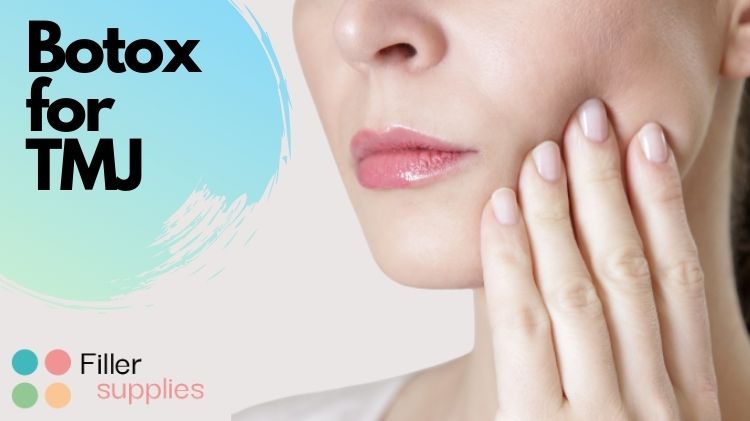How Can Botox Help With TMJ Treatment?

Botulinum toxin type A, a base for the well-known Botox, does not stop surprising the researchers by the new spheres, disorders, and diseases where it can be effective. In our blog, we have already spoken about Botox for breast lift, lip flip, gummy smile, severe headaches and migraines, erectile dysfunction in men, not to mention cosmetic purposes like smoothing out forehead lines and crow’s feet.
Now, multiple tests prove that Botox injections can help to relieve the symptoms of the temporomandibular joint disorder (TMJ), the only movable joint in our head, the one that connects the lower jaw bone with the rest of the skull (temporal bone). This joint is very active as it takes part in chewing, speaking, laughing, swallowing, and many other daily activities. Thus, the tension on this joint is more than intense. Due to certain disorders, displacement, traumas, overworking through excessive teeth grinding, a person may experience pain in the jaw muscles, which may cause unbearable tension headaches. To relieve the pain, doctors offer an innovative and maybe a little bit surprising treatment (but very effective) – Botox injections. Don’t forget, we are the official supplier of Botox in the USA and you can buy Botox online and save up to 40%. Only if you have a license. Let us examine closely the way the drug helps for TMJ disorder, its benefits, side effects, risks, procedure, and everything else you may need to know before visiting the doctor.
How Does BOTOX Treat Jaw Tension, Jaw Pain, and TMJ Disorders?
Botox from Allergan is a neuro relaxant that is aimed at blocking nerve endings. When they are under the impact of the toxin, the nerves are unable to receive and correspondingly transfer the signal from the brain to the muscles, thus the patient does not feel the pain. The injections do not provide immediate effect, and you will need up to 4 days to see the first results, which will fully reveal closer to the second week after the procedure.
The administration of Botox treatment for TMJ pain is performed into the intermediate layers of the masseter muscles, so do not worry like your whole jaw will be immobilized. Moreover, the effect of botulinum toxin is always temporary and will decrease after 4 to 6 months, depending on how fast the nerves will be able to grow new endings and renew their sensitivity.
How long does the Botulinum Toxin Treatment Procedure Take?
Botox treatment belongs to the so-called non-invasive or non-surgical manipulations that will not take much of your time. Of course, you will need a consultation before the treatment to check for any contraindications, discuss possible side effects, complications, measures to take before and after the procedure, but the process of injecting is quite simple and fast.
On average, the whole procedure may take a maximum of 60 minutes or less. It depends on the number of needed injections into the masseter muscle on both sides of the face or just one.
Is Botox for TMJ Treatment Painful?
As I have mentioned before, the injections of Botox are not a surgical procedure. Thus, there will be no severe invasion into the skin or muscles. The injections themselves do not differ from any other injections you used to have with your physicians. If you are not scared of injections, you can compare the pain to a bug bite. But if you do, you should inform the doctor and ask him/her to apply a local anesthetic on the skin of the jaw to make the procedure more comfortable. In our time of advanced medicine and cosmetology, it is not a problem anymore.
When the injections are done, and the action of lidocaine is finished, you may feel some discomfort in the areas of injections like slight pain, redness, swelling. With some patients, these symptoms go after a few hours, with others, it may continue for 2-3 days. It is always individual and depends on the sensitivity of the organism. In any case, at home, you can use a cold pack of ice, for instance, for pain relief.
What to Expect After the Botulinum Toxin TMJ Treatment?
When you leave the office of your dentist, cosmetologist, or physician, you will not notice any unbelievable results at once. The skin of your face will be irritated (we will speak on the possible dermal reactions in more detail a little bit later in this article), and there may be a slight feeling of numbness, especially if the doctor applied lidocaine.
During the first few days, botulinum toxin will gradually start working, blocking the nerve endings in the masseter muscle, the jaw tension will slowly decrease, and the pain in the temporomandibular joint will gradually weaken until it fully disappears till the end of the second week after the injection. At the same time, it should no way affect the mouth movements or create any difficulty with speaking, eating, etc.
What is the Recovery from Botulinum Toxin Therapy for TMJ Treatment Like?
Good news for those who thought there would be some hospitalization or vacation required to recover after physical therapy with Botox. Fortunately, botulinum toxin treatments for TMD do not suppose any of these, and you can resume your daily activity, go back to work, and do the things you used to do (with some restrictions) directly after you live the cabinet of the doctor. Of course, your appearance may become one of the issues to take a day off or work remotely from home, as your face may be red, swelled, sometimes bruised, and you may feel uncomfortable when your colleagues and other people see you not at your best.
Although Botox treatments do not belong to serious manipulations, you should be ready that the injection of botulinum toxin into the muscle may cause certain skin and body reactions to the foreign substance in the tissues, and you will have to give your organism some time to recover from the stress.
Botox for TMJ Side Effects:
So, the most common reactions observed in patients after treatment with botox for TMD are:
- redness;
- swelling;
- itching;
- bruising;
- sensitivity;
- tissue discoloration.
All these are local reactions at the injection site. There may be some general reactions like:
- weakness;
- headaches;
- nausea.
Any of these conditions are temporary and should disappear within the next few hours, a maximum of a few days. If you notice that some side effect lasts longer than it is supposed to, immediately contact your doctor and get medical consultation.
At-Home Tips for Relieving your TMJ after Botox
First of all, I want to give you a few recommendations on safety rules after having Botox for TMJ disorders that will help you to minimize the manifestations of body and skin reactions as well as prevent the appearance of any more severe complications. Do not forget that although that may be no so obvious evidence of invasion in your skin, there are still tiny wounds that are open, and you should take care you do not put your skin at any risk of infection. That is why you should avoid or at least minimize all the factors that put you under stress and may cause any damages.
Botox Jaw Injections After Tips
- do not use heavy makeup cosmetics or better fully refuse from makeup for a few days after jaw Botox injections;
- do not rub or massage your jaw muscles as such movements may cause the toxin to migrate to the neighboring areas, so avoid touching your face;
- do not do intensive physical exercises, fitness, and so on;
- do not visit such public places as gyms and pools to avoid catching an infection;
- avoid exposure to high temperatures at spas, sauna, beaches, even hot baths or showers. It may also have a negative impact on your Botox TMD treatment.
Tips to Minimize the Pain in the Jaw Joint
As for your jaw disorders, here are some advice on how to decrease the tension in the muscles and joints and strengthen the effect after Botox:
- find a way to relax and relieve stress (yoga, meditation, massages) to decrease the general tension in the body;
- do not slump or slouch. The wrong posture increases the tension in all tissues;
- try to notice and control arbitrary jaw clenching;
- relax your lower jaw muscles and do not lunch your teeth unless you are eating;
- minimize or better get rid of such habits as constant chewing gum, biting nails, eating tough or sticky foods.
All these simple recommendations are useful not just for your jaw but health in general, and sometimes such a trifle issue as chewing gum may become a point for developing TDM disorders and severe headaches.
Risks & Limitations of Botox Injections for TMJ Treatment
Like most treatments, the procedure of Botox has a certain list of factors that may delay or cancel the procedure. Thus, the patient can not have Botox treatment in the following cases:
- minor age (under 18);
- conditions of pregnancy or lactation;
- bleeding disorders;
- infections or inflammation of the skin at the treated area;
- diabetes;
- cancer.
There may be some other contraindications. The doctor will study your health to determine whether a Botox injection is right for you or not. If the answer is negative, he/she will recommend you other treatment options.
To Sum Up
Painful feelings in your jaw must be irritating and create a lot of discomfort in everyday life. Ordinary habits, uncontrolled teeth grinding, stress, etc. create tension in the muscle and joint, spoiling the quality of life. Fortunately, there are a few solutions to the problem, and jaw Botox is one of the ways out. the researchers are still testing and investigating the method, but it is indeed promising. The toxin is already widely used by cosmetologists, physicians, and even dentists. It is one of the most well-studied drugs in the world, but almost every day, we get more exciting news where it can be helpful and effective. If you suffer from any symptoms of discomfort in the lower jaw, talk to your doctor about the possibility to relax the muscle with botulinum toxin. Maybe, this is a perfect choice for you. I hope this article was interesting and useful to you. You can subscribe to our blog for more news from the sphere of health and cosmetology.
Stay healthy! Stay beautiful! See you in the next post!


